Moving to a diet that doesn’t include dairy or gluten can be intimidating. Most whole foods, however, don’t contain dairy or gluten, so creating a diet around those items makes the process easier. In addition, manufacturers now offer a range of gluten and dairy-free foods, so the transition won’t be too hard.
When making this switch, focus on foods that remain in the diet rather than those that don’t. In addition, learn how to read labels on products and uncover hidden ingredients. Spend time researching alternatives to favorite foods so removing them from the diet won’t be as hard. It is possible to follow a gluten and dairy free diet if you follow a few simple steps.
Table of Contents
Why Eliminate Gluten?
Gluten is a type of protein found in many grains. Its stretchy quality makes it ideal for holding baked goods together. However, the consumption of gluten leads to inflammation in many individuals. It contains anti-nutrients that interfere with the body’s ability to absorb and digest vital nutrients. This leads to inflammation in the gut. In addition, the consumption of gluten leads to the release of Zonulin in the body, which causes the body to mount an immune system response that brings about inflammation.
Why Eliminate Dairy?
Mammals produce milk, and any milk produced by a mammal is considered a dairy product. Today, cow’s milk it the most commonly consumed milk in North America, and it is also the most allergenic. Many products today contain dairy, although eggs do not. Dairy products are difficult to digest, which can lead to inflammation. In addition, special proteins are needed to digest dairy. If these proteins are lacking, inflammation becomes a concern.
Gluten and Dairy-Free Foods
Many foods don’t contain gluten or dairy. This includes whole grains, beans, legumes, nuts, seeds, fruits, and vegetables. Build a diet around these items for three weeks, as gluten takes three weeks to exit your system completely while dairy takes two weeks. By eating only these items, a person can ensure they completely eliminate both from their system. Many foods contain hidden gluten or dairy, so eating only whole foods ensures those ingredients aren’t present in the diet.
Starting a Gluten and Dairy-Free Diet
During this three-week period, remove any items in the home that contain gluten or dairy. Reading the food labels is crucial to ensuring all are removed. Learn what ingredients in foods may contain gluten or dairy, such as brewer’s yeast or malt. When purchasing packaged foods to replace these items, look for those that say they are certified gluten-free or certified vegan. An easy way to find these items is to look for products that say Whole30 compliant. This means they don’t contain gluten or dairy.
Reintroduce Foods
To see what is causing the reaction, add a new food to the diet. Eat it twice in one day and then don’t eat it again for three days. Don’t eat any other new foods during this three-day period either. This makes it easy to learn which foods are causing a reaction. If a food causes a reaction, write it down. This information can be shared with the medical team to ensure nothing else is going on in the body that the team needs to know about.
Following a gluten and dairy-free diet isn’t difficult once a person knows how to do so. The tips shared above are helpful in determining which foods are leading to a reaction and which can be eaten safely. Implement them today to see how they allow you to feel better and lead a more active life.

